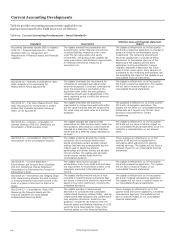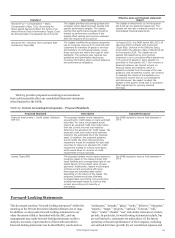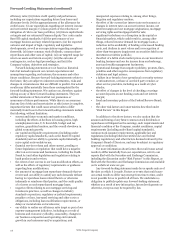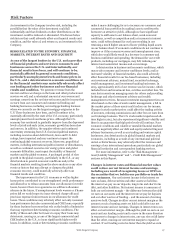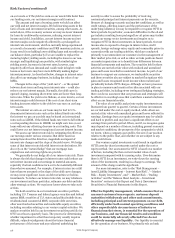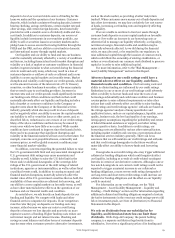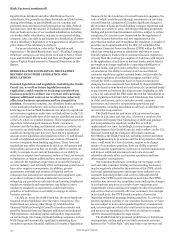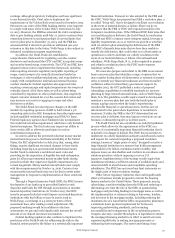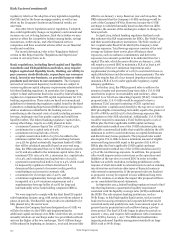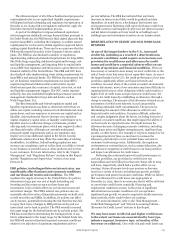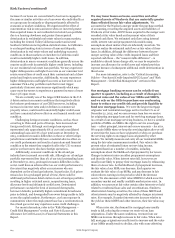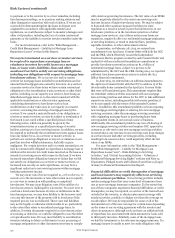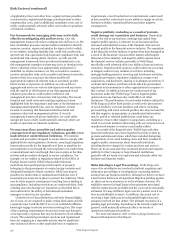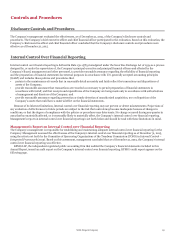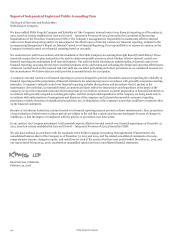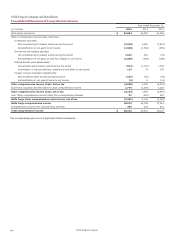Wells Fargo 2015 Annual Report Download - page 126
Download and view the complete annual report
Please find page 126 of the 2015 Wells Fargo annual report below. You can navigate through the pages in the report by either clicking on the pages listed below, or by using the keyword search tool below to find specific information within the annual report.Risk Factors (continued)
increase if our loans are concentrated to borrowers engaged in
the same or similar activities or to borrowers who individually or
as a group may be uniquely or disproportionately affected by
economic or market conditions. We experienced the effect of
concentration risk in 2009 and 2010 when we incurred greater
than expected losses in our residential real estate loan portfolio
due to a housing slowdown and greater than expected
deterioration in residential real estate values in many markets,
including the Central Valley California market and several
Southern California metropolitan statistical areas. As California
is our largest banking state in terms of loans and deposits,
deterioration in real estate values and underlying economic
conditions in those markets or elsewhere in California could
result in materially higher credit losses. In addition,
deterioration in macro-economic conditions generally across the
country could result in materially higher credit losses, including
for our residential real estate loan portfolio. We may experience
higher delinquencies and higher loss rates as our consumer real
estate secured lines of credit reach their contractual end of draw
period and begin to amortize. Additionally, we may experience
higher delinquencies and higher loss rates as borrowers in our
consumer Pick-a-Pay portfolio reach their recast trigger,
particularly if interest rates increase significantly which may
cause more borrowers to experience a payment increase of more
than 7.5% upon recast.
We are currently one of the largest CRE lenders in the U.S.
A deterioration in economic conditions that negatively affects
the business performance of our CRE borrowers, including
increases in interest rates and/or declines in commercial
property values, could result in materially higher credit losses
and have a material adverse effect on our financial results and
condition.
Challenging foreign economic conditions, such as those
occurring in China and parts of Europe, have increased our
foreign credit risk. Although our foreign loan exposure
represented only approximately 6% of our total consolidated
outstanding loans and 3% of our total assets at December 31,
2015, continued economic difficulties in these or other foreign
jurisdictions could indirectly have a material adverse effect on
our credit performance and results of operations and financial
condition to the extent they negatively affect the U.S. economy
and/or our borrowers who have foreign operations.
Additionally, economic conditions in the oil and gas
industry have increased our credit risk. Although our oil and gas
portfolio represented less than 2% of our total outstanding loans
at December 31, 2015, prolonged economic difficulties in this
sector could have an adverse effect on our credit performance to
the extent they negatively affect our customers who are
dependent on the oil and gas industry. In particular, if oil prices
remain low for a prolonged period of time, there could be
additional performance deterioration in our oil and gas portfolio
resulting in higher criticized assets, nonperforming loans,
allowance levels and ultimately credit losses. Deteriorated
performance can take the form of increased downgrades,
borrower defaults, potentially higher commitment drawdowns
prior to default, and downgraded borrowers being unable to fully
access the capital markets. Furthermore, our loan exposure in
communities where the employment base has a concentration in
the oil and gas sector may experience some credit challenges.
For more information, refer to the “Risk Management –
Credit Risk Management” section and Note 6 (Loans and
Allowance for Credit Losses) to Financial Statements in this
Report.
We may incur losses on loans, securities and other
acquired assets of Wachovia that are materially greater
than reflected in our fair value adjustments. We
accounted for the Wachovia merger under the purchase method
of accounting, recording the acquired assets and liabilities of
Wachovia at fair value. All PCI loans acquired in the merger were
recorded at fair value based on the present value of their
expected cash flows. We estimated cash flows using internal
credit, interest rate and prepayment risk models using
assumptions about matters that are inherently uncertain. We
may not realize the estimated cash flows or fair value of these
loans. In addition, although the difference between the pre-
merger carrying value of the credit-impaired loans and their
expected cash flows – the “nonaccretable difference” – is
available to absorb future charge-offs, we may be required to
increase our allowance for credit losses and related provision
expense because of subsequent additional credit deterioration in
these loans.
For more information, refer to the “Critical Accounting
Policies – Purchased Credit-Impaired (PCI) Loans” and “Risk
Management – Credit Risk Management” sections in this
Report.
Our mortgage banking revenue can be volatile from
quarter to quarter, including as a result of changes in
interest rates and the value of our MSRs and MHFS,
and we rely on the GSEs to purchase our conforming
loans to reduce our credit risk and provide liquidity to
fund new mortgage loans. We were the largest mortgage
originator and residential mortgage servicer in the U.S. as of
December 31, 2015, and we earn revenue from fees we receive
for originating mortgage loans and for servicing mortgage loans.
As a result of our mortgage servicing business, we have a sizeable
portfolio of MSRs. An MSR is the right to service a mortgage
loan – collect principal, interest and escrow amounts – for a fee.
We acquire MSRs when we keep the servicing rights after we sell
or securitize the loans we have originated or when we purchase
the servicing rights to mortgage loans originated by other
lenders. We initially measure and carry all our residential MSRs
using the fair value measurement method. Fair value is the
present value of estimated future net servicing income,
calculated based on a number of variables, including
assumptions about the likelihood of prepayment by borrowers.
Changes in interest rates can affect prepayment assumptions
and thus fair value. When interest rates fall, borrowers are
usually more likely to prepay their mortgage loans by refinancing
them at a lower rate. As the likelihood of prepayment increases,
the fair value of our MSRs can decrease. Each quarter we
evaluate the fair value of our MSRs, and any decrease in fair
value reduces earnings in the period in which the decrease
occurs. We also measure at fair value MHFS for which an active
secondary market and readily available market prices exist. In
addition, we measure at fair value certain other interests we hold
related to residential loan sales and securitizations. Similar to
other interest-bearing securities, the value of these MHFS and
other interests may be negatively affected by changes in interest
rates. For example, if market interest rates increase relative to
the yield on these MHFS and other interests, their fair value may
fall.
When rates rise, the demand for mortgage loans usually
tends to fall, reducing the revenue we receive from loan
originations. Under the same conditions, revenue from our
MSRs can increase through increases in fair value. When rates
fall, mortgage originations usually tend to increase and the value
of our MSRs usually tends to decline, also with some offsetting
Wells Fargo & Company
124


